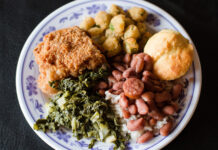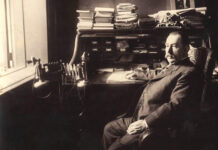
On February 6, 1897, a tall, scholarly-looking man placed a piece of stationery on his desk and penned a short note to an old friend in north Alabama. “I am sending off the book today to try its fate,” he announced. The writer was Peter Joseph Hamilton, a Mobile lawyer and enthusiastic local historian. His recipient was Thomas McAdory Owen, an attorney, cofounder of the Southern History Association and soon-to-be director of the Alabama Department of Archives and History.
Owen had helped Hamilton conduct his research, and he eagerly anticipated its dissemination. The book in question, “Colonial Mobile,” published by Houghton, Mifflin and Company in 1897 and subsequently much revised and enlarged in 1910, quickly achieved classic status. To this day, its wide spine graces numerous Mobile Bay-area bookshelves, and it continues to serve as a valuable reference for amateur and professional historians alike.
Hamilton’s fascination with Gulf Coast history dated to childhood. Born in 1859 to Mobile attorney Peter Hamilton and his wife, Anna Martha Beers, he vividly recalled the Civil War and its tumultuous aftermath. In his posthumously published book “A Little Boy in Confederate Mobile” (1947), he described the day the federal magazine exploded north of Downtown. He was playing with his nanny in the yard of his parents’ Government Street house when it happened.
“I was on top of the fence,” he wrote, “when we felt … an earthquake, indeed two or more in succession and, as we looked fearfully toward the city, over it swept a black cloud, dividing in two in the wind.” After the war, the youngster attended Mobile’s Towle Institute and then Bellfonte Academy, a Pennsylvania private school, before entering Princeton University. Among his classmates was future U.S. president Woodrow Wilson, or Tommy, as Peter Joe called him. Hamilton graduated in 1879, traveled to Germany to study philosophy, and then returned to the U.S. and took a law degree at the University of Alabama. He joined his father’s legal practice in Mobile, married Rachel W. Burgett in 1891 (they had a son and two daughters), served on the Mobile City Council and in 1894, became city attorney.
Hamilton’s professional responsibilities provided him ready access to Mobile’s voluminous historical records, some of which dated to colonial times. When not lawyering, he wrote dozens of short articles for publications like the Mobile Daily Register, the New Orleans Times-Democrat and the American Historical Magazine, highlighting Gulf Coast history and sites like Church Street Graveyard, Fort Charlotte and Spring Hill. He also produced longer works, including his first book, “Rambles in Historic Lands” (1893), based on his European travel; “Art Work of Mobile and Vicinity” (1894), a large-format volume featuring memorable photographs; and a “Code of Ordinances” (1895) for the city, distinguished by a detailed historical introduction.
Peter Joseph Hamilton
The restoration of the past is a prerequisite to understanding the present. It is inspiring to reflect, that we, too, even if our part be small, like that of the coral, are helping to build up a future.
Nowhere did he so focus his energies and passion as on “Colonial Mobile.” The book’s ponderous subtitle, “An Historical Study Largely from Original Sources, of the Alabama-Tombigbee Basin from the Discovery of Mobile Bay in 1519 until the Demolition of Fort Charlotte in 1821,” gives an idea of its ambition and sweep. Nonetheless, Hamilton recognized his study’s shortcomings even before publication. His grasp of the area’s Indian history proved tentative, and his coverage of the British and early American periods was weak. During the early 1900s, he expanded and improved the narrative, adding 11 new chapters and 22 appendices. The latter are especially fascinating and include a list of the Pelican Girls, a map of early Spanish land grants superimposed on the city’s modern street grid, and the Acts of the British West Florida Assembly. “If I have succeeded,” he wrote in a new preface, “I have added some facts not generally known, and established a new angle or point of view for an important section of American history.”
Reviewers took note. Pierce Butler opined in The American Historical Review that the new edition “adds a good deal of value to a book already favorably known as a painstaking monograph.” A critic for The Nation admired Hamilton’s parade of theretofore unfamiliar figures like Jean Baptist Le Moyne de Bienville, Robert Farmar, Elias Durnford, Bernardo de Galvez and Sam Dale. “The names of men, who had they lived and fought and founded and builded in New England or New York or Virginia or the Carolinas would probably have been as well known to us as John Winthrop or Peter Stuyvesant or Nathaniel Bacon,” he wrote, “are somehow, because they belong instead to Louisiana or the Bigbee country, or West Florida, hardly known at all.” In recognition of his achievement, the University of Alabama and Spring Hill College bestowed honorary degrees on Hamilton.
Not one to rest on his laurels, Hamilton continued to travel, write, and work. More books followed, including “The Reconstruction Period” in 1910 and a high school textbook, “Mobile of the Five Flags,” three years later. In 1913, his old classmate Tommy, who had ascended to the presidency, appointed him to a federal judgeship in Puerto Rico where he served until 1921. Afterwards, he taught law at Southern Methodist University in Dallas until he developed health issues and moved in with one of his daughters in Anniston, where he passed in 1927.
The Creoles loved the water, and any map giving Spanish concessions will show their oblong white spaces, uncut by the land-office surveys, facing bay and rivers, but with few of them away from the water.
Peter Joseph Hamilton
Historians still consult “Colonial Mobile” almost a century beyond Hamilton’s death, though they cite the usual caveats one would expect with an older work. In a 1994 interview, British West Florida historian Robert Rea called the book “a noteworthy piece of historical literature” but added that Hamilton “wrote as a Victorian Alabamian and had limited access to materials.” In response to an inquiry for this article, Greg Waselkov, a retired University of South Alabama archaeologist, stated in an email, “Hamilton’s ‘Colonial Mobile’ remains an important reference. I always keep a copy within reach at my desk, not for history writ large, since his takes on de Soto and Bienville have not aged well, but for the details of daily life. Like no other historian before or since, Hamilton mined the local municipal and probate and land office records to track the accomplishments and failures of individual French, British and Spanish colonists during Mobile’s formative years.”
“Colonial Mobile” retains considerable power to delight and instruct. For anyone intrigued by the city’s colorful early history, there is no more worthy companion on a rainy evening when, as Hamilton so memorably wrote, the “imagination loves to wander back and picture the scenes before that change from Latin to American civilization.”
“Colonial Mobile” is currently out of print. However, copies of its 1952 and 1976 editions are readily available online from sites like Amazon and Abebooks and it has been digitized by the Library on Congress for all to peruse. The 1976 reprint includes a fine introduction by Charles C. Summersell and a full bibliography.
John S. Sledge is the co-author of “Mobile and Havana: Sisters Across the Gulf” and has produced seven other books of local history.





